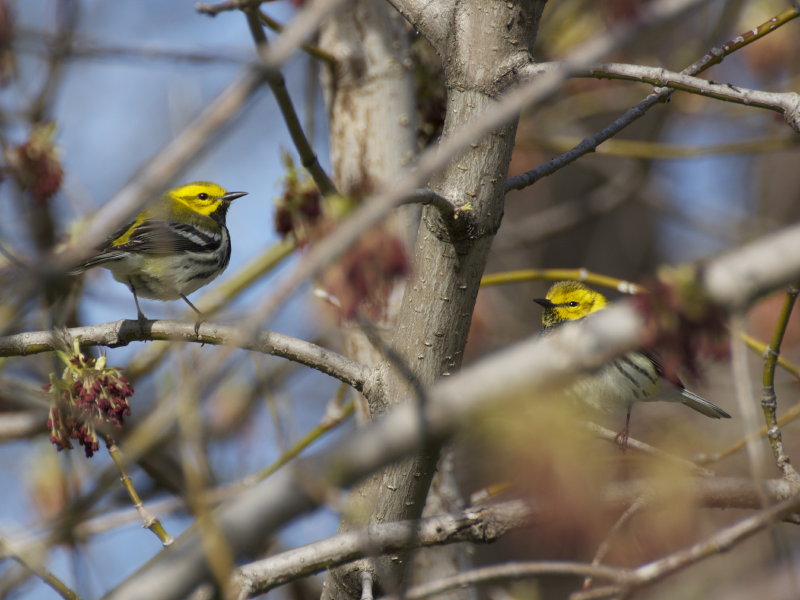I worked in a Downtown office building for many years. Times would come – I never kept track of the time of year – when we would find beautiful little birds dead on the sidewalk every day for a few weeks. I always wondered what was happening, but kept forgetting to look it up. What were those birds?
At the same time I would walk my dog in Lake Park and smile at the birders in their floppy khaki hats. I would squint up into the woods where they gathered, and I didn’t see anything. What did they see?
Then I learned the answer – to both questions. It was warbler time.
Late April and May in Wisconsin is warbler time. Many people experience warbler time mostly by finding dead birds, but warbler time is much more about life than about death – life and strength and persistence and the rhythm of seasons and climate.
Of the many species of wood warblers, more than 30 come through Wisconsin every spring, in huge numbers. They winter far south, usually in Mexico or Central America. They summer far north, usually in Canada. To find their way from one to the other, they follow long visible lines – like the coast of Lake Michigan. Luckily for us, they stop in Milwaukee on the way.
They are beautiful, beautiful little birds, brightly colored and patterned in many different ways. The Yellow Warbler like a fat little sunburst. The Cape May Warbler with jowls the color of a fresh egg yolk. The Black-Throated Green Warbler with its bright yellow cheeks. The American Redstart, black and orange like a tiny oriole. The Palm Warbler with its little brown hat. The Yellow-Rumped Warbler, all over the woods this spring, with its black Zorro mask and bright yellow patches.
How to find warblers
Surprisingly for anyone who has lived here awhile and never noticed them, warblers are easy to find. They almost never come to feeders, because their favorite food is live bugs. (Have you grumbled about those clouds of tiny bugs in the parks right now? Be grateful!) Warblers are in the trees and shrubs, and, because they’re chasing bugs, they’re almost always moving.
So take binoculars to your nearest park with woodland, stand at the edge of the woods with the sun behind you, and wait for something to move. If it’s morning or evening and not too windy, you won’t wait long. If a little bird is hopping around the branches and has a small, thin bill, you’ve probably found your first warbler.
Once you find them, get ready to be fascinated. I sometimes wonder how many birders made the turn from casual interest to up-at-dawn obsession when they discovered warblers. It’s like a living puzzle to learn the different kinds and "collect them all."
To get you started, there’s a great one-page guide here from the Cornell Laboratory of Ornithology, and a delightfully nerdy video at their YouTube channel. A few steps farther down the path to obsession, you’ll want the iBird app if you have an iPhone, iPad, or Android. And a book ... and better binoculars ... and one of those floppy khaki hats ...
The more you know about warblers, the more you’ll also want to protect them. The dead birds downtown usually flew into windows – so sad, after they’ve come so far, and so easily prevented. At the Wisconsin Humane Society we have information here. It’s so important also to protect the parks, woods, and open areas where warblers find food and safety on their journey, and to keep indoor cats indoors where they’re safe from harm and birds are safe from them.
Hope you can get outside this weekend. Happy warbler time.
(In the picture: two black-throated green warblers who kindly posed for me in Milwaukee’s Lake Park last weekend. You can learn more about how to help birds at our wildlife pages, here.)
Anne Reed became the Executive Director of the Wisconsin Humane Society in January of 2010. Before joining WHS, Anne spent almost three decades as a corporate litigator at the Milwaukee law firm of Reinhart Boerner Van Deuren SC.
At the Wisconsin Humane Society (WHS), Anne stepped into the leadership of Wisconsin's oldest, largest and most recognized animal welfare organization. For more than 130 years, WHS has been saving the lives of animals in need, and carrying out its mission to build a community where people value animals and treat them with respect and kindness. WHS helped to pioneer the idea that every animal available for adoption in a shelter could be free of time limits, taking as long as needed to be adopted. WHS operates shelters in Milwaukee, Saukville and Racine.
Anne serves on the board of directors of the National Federation of Humane Societies (NFHS), Wisconsin Federated Humane Societies, and Shelter Animals Count, a national database initiative. She also chairs NFHS's 2020 Vision Initiative. Anne also served as president of Meta House's board of directors from 2005 to 2007 and served on the board from 2001 to 2010. As a lawyer, she was named one of the Wisconsin Law Journal's "Women In The Law;" was named to the list of "Wisconsin Superlawyers," and authored a law blog which was twice named one of the 100 best in the country by the American Bar Association's ABA Journal.



